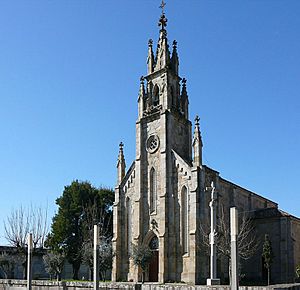Our Lady of Placeres church facts for kids
Quick facts for kids Iglesia de Nuestra Señora de Placeres |
|
|---|---|

Facade of the church
|
|
| 42°24′19.08″N 8°40′59.88″W / 42.4053000°N 8.6833000°W | |
| Location | Pontevedra, Spain |
| Country | Spain |
| Denomination | Catholicism |
| History | |
| Consecrated | 1888 |
| Architecture | |
| Groundbreaking | 1887 |
| Completed | 1888 |
| Administration | |
| Diocese | Roman Catholic Archdiocese of Santiago de Compostela |
The Our Lady of Placeres church (Igrexa da Nosa Señora dos Praceres) is a Catholic church in Pontevedra, Spain. It was built in the late 1800s. The church has a special style called neo-Gothic.
This church is in the area of Lourizán. It was built where an older, smaller chapel used to stand. This spot is at the end of the harbor entrance.
Contents
History of the Church
People have honored the Virgin of Our Lady of the Placeres here since the Middle Ages. This was because the sea near here was dangerous for sailors. A lantern warned ships about the tricky waters. It also showed where Pontevedra's waters began. Our Lady of the Placeres was believed to help sailors get past the difficult harbor entrance.
There's also a story about the pirate Francis Drake. His troops could not cross this sandbar in Lourizán. The people of Pontevedra believed the Virgin protected their city from him.
Building the New Church
In the 1880s, the local priest, Marcial Sineiro, saw that the old church was falling apart. He asked the city and the archbishop for help to build a new one. But they said no because they didn't have enough money.
So, the priest and the local people asked Eugenio Montero Ríos for help. Montero Ríos was an important politician in Spain. He spoke to the government to get approval for the new church. He also gave some of his own land near the sandbar for the church.
The architect Domingo Sesmero designed the church. The building work cost more than 72,000 pesetas.
The first stone of the church was placed on May 10, 1887. The church was finished quickly, on November 19, 1888. Because Eugenio Montero Ríos helped so much, he and his wife, Avelina Villegas Budiños, are buried inside the church. Their tomb is in a chapel next to the altar of Our Lady of Placeres.
What the Church Looks Like
The church is built in the neo-Gothic style. This style is inspired by older Gothic churches. It is made of granite stone. The central tower of the church is 33 meters (about 108 feet) tall.
Inside the Church
The church's floor plan looks like a Latin cross. It has one large main room called a nave. There are two smaller chapels near the semi-round end, which is called the apse. The nave has a special ceiling with Groin vaults. It is divided into three parts by rounded arches.
The inside of the church has Gothic decorations. There are three white marble slabs with special messages. These messages honor King Alfonso XIII, who was king when the church was built. They also honor Práxedes Mateo Sagasta, who was a prime minister, and the important Galician politician Eugenio Montero Ríos.
Outside the Church
The front of the church has tall Buttresses, which are supports on the outside walls. It ends in a tall, pointed top called a Gothic spire. The main entrance door has two curved arches around it, called Archivolts.
Above and to the sides of the door are long, narrow windows. They have pointed tops, known as pointed arches. Above the central window, there is a round window called a rose window. It looks like a four-petal flower.
The church's main entrance and its overall layout face east. This is unusual because most churches face west, towards the sea.
Gallery
See also
 In Spanish: Iglesia de Nuestra Señora de los Placeres para niños
In Spanish: Iglesia de Nuestra Señora de los Placeres para niños
Related articles





